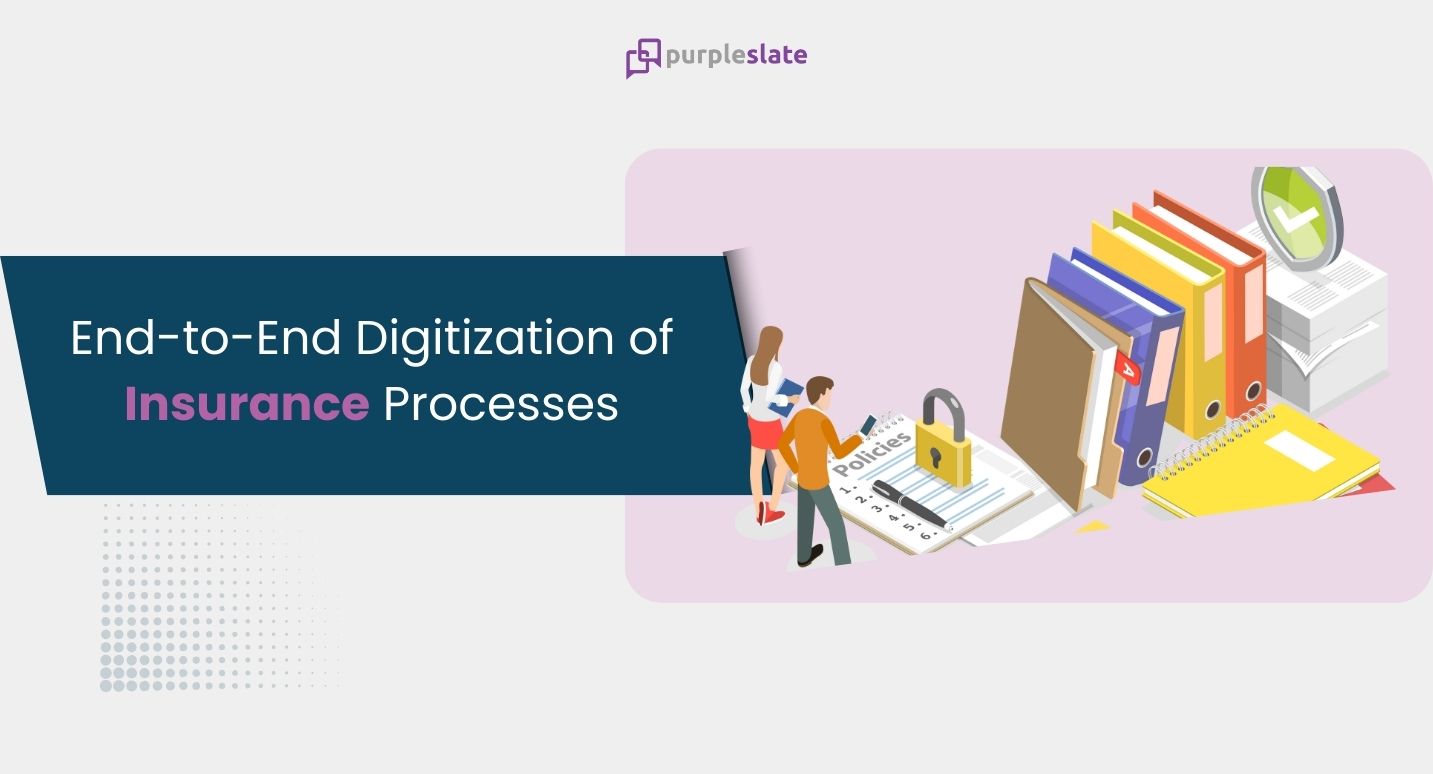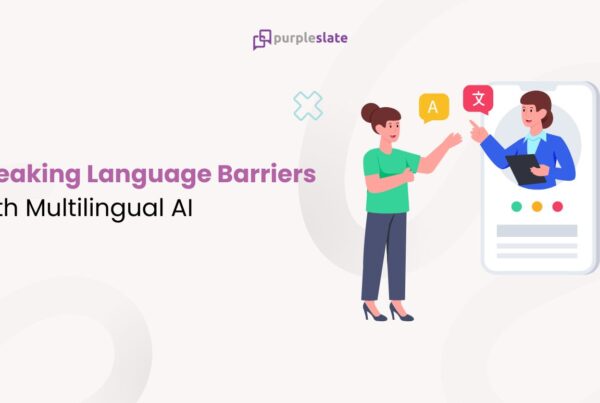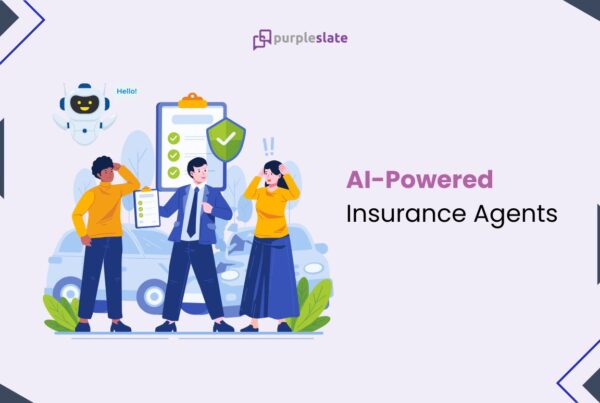
Introduction
The insurance sector is under tremendous pressure to modernize and improve customer experiences in the quickly changing digital landscape. A complete way to optimize operations and create smooth, customer-focused experiences is through the end-to-end digitization of insurance processes. This blog highlights the role of Conversational AI solutions in revolutionizing the industry as it examines the essential elements, advantages, difficulties, and solutions related to this revolutionary approach.
The Imperative for Digitization in Insurance
The traditional insurance model, characterized by manual processes, extensive paperwork, and prolonged turnaround times, no longer meets the expectations of today’s digitally savvy customers. The demand for instant gratification, transparency, and efficiency necessitates a shift towards digital operations. By digitizing insurance processes end-to-end, insurers can achieve:
- Operational Efficiency: Automation reduces manual intervention, minimizes errors, and speeds up processes.
- Customer Satisfaction: Seamless digital interactions enhance customer experience and build trust.
- Competitive Edge: Digital innovation helps insurers stay ahead in a competitive market.
Key Components of End-to-End Digitization
Customer Onboarding
- Digital KYC (Know Your Customer): Automated identity verification and data collection through digital platforms streamline the onboarding process. Customers can complete KYC procedures quickly and conveniently, reducing the time and effort required for policy acquisition.
- Online Policy Purchase: User-friendly online interfaces allow customers to browse, compare, and purchase insurance policies without the need for physical visits or lengthy paperwork. Instant policy issuance enhances customer satisfaction and loyalty.
Policy Management
- Digital Documentation: Electronic policy documents accessible through web or mobile applications provide customers with easy access to their insurance information. Digital documentation eliminates the need for physical storage and reduces the risk of document loss.
- Automated Underwriting: AI-driven underwriting processes assess risks and issue policies with minimal human intervention. Automated underwriting ensures consistent and fair decision-making, reduces processing time, and enhances operational efficiency.
Claims Processing
- Automated Claims Submission: Digital platforms enable customers to file claims online, simplifying the submission process and reducing paperwork. Automated systems guide customers through the necessary steps, ensuring accurate and complete submissions.
- AI-Powered Claims Assessment: Advanced AI algorithms evaluate claims, detect fraud, and expedite payouts. AI-driven claims assessment enhances accuracy, reduces processing time, and ensures prompt and fair settlements.
Customer Service
- Chatbots and Virtual Assistants: Conversational AI solutions, such as chatbots and virtual assistants, provide instant support and handle customer queries 24/7. These AI-driven tools can manage routine inquiries, assist with policy details, and guide customers through claims processes, offering consistent and efficient service across multiple channels.
- Omnichannel Support: A unified customer service experience across various channels (web, mobile, social media) ensures that customers receive consistent support regardless of their preferred communication method. Omnichannel support enhances customer satisfaction and engagement.
Benefits of Digitizing Insurance Processes
Enhanced Customer Experience
- Convenience: Customers can interact with their insurer anytime, anywhere, through digital platforms. Online policy management, claims submission, and customer service provide unparalleled convenience.
- Speed: Faster policy issuance and claims processing improve customer satisfaction. Automation reduces processing times, allowing customers to receive prompt service and support.
Operational Efficiency
- Cost Reduction: Automation reduces the need for manual processes, leading to significant cost savings. Digitized operations minimize administrative overhead and resource requirements.
- Scalability: Digital processes can handle a higher volume of transactions without a proportional increase in resources. Scalability ensures that insurers can grow their business without compromising service quality.
Accuracy and Compliance
- Reduced Errors: Automated processes minimize human errors, ensuring accurate and consistent operations. Error-free processes enhance customer trust and reduce the risk of disputes.
- Regulatory Compliance: Digital records and automated workflows ensure compliance with regulatory requirements. Compliance management becomes more straightforward and efficient, reducing the risk of penalties.
Competitive Advantage
- Innovation: Digital transformation allows insurers to introduce innovative products and services. Technological advancements enable insurers to stay ahead of competitors and meet evolving customer expectations.
- Market Responsiveness: Agility to quickly adapt to market changes and customer demands. Digital operations provide the flexibility to respond to emerging trends and opportunities.
Overcoming Challenges in Digitization
While the benefits of end-to-end digitization are clear, the journey towards fully digital insurance processes presents several challenges:
- Integration with Legacy Systems: Modernizing existing systems and ensuring seamless integration with new digital platforms can be complex and resource-intensive. A phased approach to integration and the use of middleware solutions can help mitigate these challenges.
- Data Security and Privacy: Ensuring robust security measures to protect sensitive customer information is critical. Implementing advanced encryption, access controls, and regular security audits can safeguard data integrity and confidentiality.
- Change Management: Training employees and managing the cultural shift towards digital-first operations can be challenging. Effective change management strategies, including employee training, communication, and stakeholder engagement, are essential for a smooth transition.
- Customer Adoption: Encouraging customers to adopt and trust digital channels over traditional methods requires targeted communication and education. Demonstrating the benefits of digital interactions and providing user-friendly interfaces can drive customer adoption.
The Role of Conversational AI in Digital Transformation
Conversational AI solutions play a pivotal role in the end-to-end digitization of insurance processes. These AI-driven tools use natural language processing (NLP) and machine learning to enable smart conversations between customers and insurers. Key benefits of Conversational AI solutions include:
- Enhanced Customer Engagement: Conversational AI tools provide instant, personalized interactions, enhancing customer engagement and satisfaction. AI-driven chatbots and virtual assistants can handle a wide range of inquiries, from policy details to claims assistance, providing a seamless and efficient customer experience.
- Improved Efficiency: Automating routine tasks and inquiries frees up human resources to focus on more complex issues. Conversational AI tools can handle high volumes of interactions simultaneously, ensuring prompt and accurate responses.
- Cost Savings: Reducing the need for human intervention in routine tasks leads to significant cost savings. Conversational AI tools can operate 24/7 without additional staffing costs, providing continuous support and service.
- Data Insights: Analyzing interactions through Conversational AI tools provides valuable insights into customer behavior and preferences. These insights can inform product development, marketing strategies, and customer service improvements.
Future Prospects of Digitization in Insurance
As digital transformation continues to evolve, the future of the insurance industry looks promising. Emerging technologies such as blockchain, Internet of Things (IoT), and advanced AI will further enhance the capabilities of digital insurance processes. Insurers can expect even greater efficiency, security, and personalization in their services.
Blockchain technology, for instance, can provide secure and transparent record-keeping, reducing fraud and enhancing trust between insurers and customers. IoT devices can offer real-time data on insured assets, allowing for more accurate risk assessment and personalized premiums.
Conclusion
The end-to-end digitization of insurance processes is essential for insurers aiming to stay competitive in the digital age. By transforming traditional workflows into efficient, customer-centric digital operations, insurance companies can enhance customer journeys and achieve operational excellence. Conversational AI solutions are instrumental in this transformation, enabling insurers to provide smart, personalized interactions that meet the evolving needs of their customers.
For insurers seeking to embark on this transformative journey, leveraging the expertise of companies specializing in Conversational AI applications can be a game-changer. These solutions, which use voice and text as primary interfaces, can revolutionize the way customers interact with insurance services, driving satisfaction, efficiency, and innovation.




